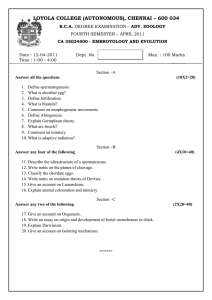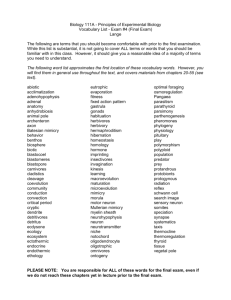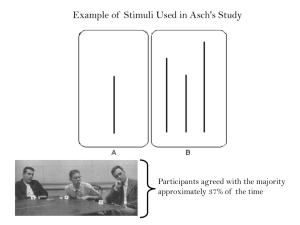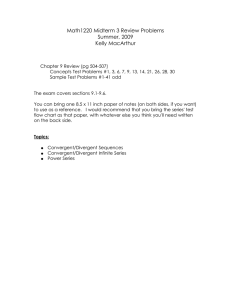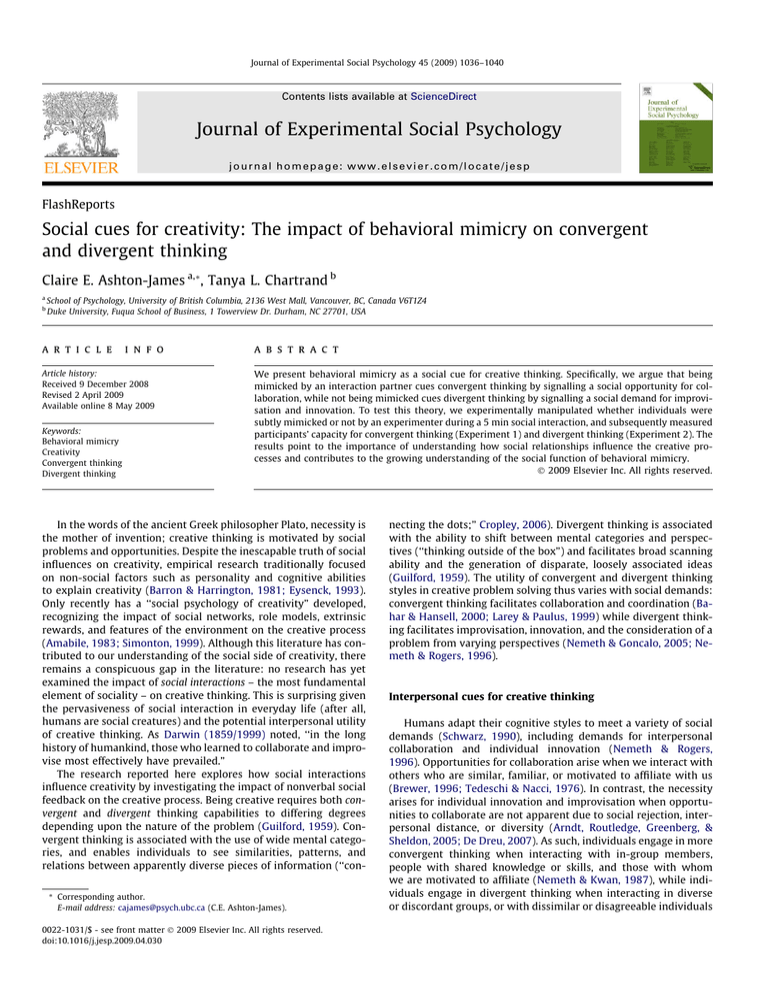
Journal of Experimental Social Psychology 45 (2009) 1036–1040
Contents lists available at ScienceDirect
Journal of Experimental Social Psychology
journal homepage: www.elsevier.com/locate/jesp
FlashReports
Social cues for creativity: The impact of behavioral mimicry on convergent
and divergent thinking
Claire E. Ashton-James a,*, Tanya L. Chartrand b
a
b
School of Psychology, University of British Columbia, 2136 West Mall, Vancouver, BC, Canada V6T1Z4
Duke University, Fuqua School of Business, 1 Towerview Dr. Durham, NC 27701, USA
a r t i c l e
i n f o
Article history:
Received 9 December 2008
Revised 2 April 2009
Available online 8 May 2009
Keywords:
Behavioral mimicry
Creativity
Convergent thinking
Divergent thinking
a b s t r a c t
We present behavioral mimicry as a social cue for creative thinking. Specifically, we argue that being
mimicked by an interaction partner cues convergent thinking by signalling a social opportunity for collaboration, while not being mimicked cues divergent thinking by signalling a social demand for improvisation and innovation. To test this theory, we experimentally manipulated whether individuals were
subtly mimicked or not by an experimenter during a 5 min social interaction, and subsequently measured
participants’ capacity for convergent thinking (Experiment 1) and divergent thinking (Experiment 2). The
results point to the importance of understanding how social relationships influence the creative processes and contributes to the growing understanding of the social function of behavioral mimicry.
Ó 2009 Elsevier Inc. All rights reserved.
In the words of the ancient Greek philosopher Plato, necessity is
the mother of invention; creative thinking is motivated by social
problems and opportunities. Despite the inescapable truth of social
influences on creativity, empirical research traditionally focused
on non-social factors such as personality and cognitive abilities
to explain creativity (Barron & Harrington, 1981; Eysenck, 1993).
Only recently has a ‘‘social psychology of creativity” developed,
recognizing the impact of social networks, role models, extrinsic
rewards, and features of the environment on the creative process
(Amabile, 1983; Simonton, 1999). Although this literature has contributed to our understanding of the social side of creativity, there
remains a conspicuous gap in the literature: no research has yet
examined the impact of social interactions – the most fundamental
element of sociality – on creative thinking. This is surprising given
the pervasiveness of social interaction in everyday life (after all,
humans are social creatures) and the potential interpersonal utility
of creative thinking. As Darwin (1859/1999) noted, ‘‘in the long
history of humankind, those who learned to collaborate and improvise most effectively have prevailed.”
The research reported here explores how social interactions
influence creativity by investigating the impact of nonverbal social
feedback on the creative process. Being creative requires both convergent and divergent thinking capabilities to differing degrees
depending upon the nature of the problem (Guilford, 1959). Convergent thinking is associated with the use of wide mental categories, and enables individuals to see similarities, patterns, and
relations between apparently diverse pieces of information (‘‘con* Corresponding author.
E-mail address: cajames@psych.ubc.ca (C.E. Ashton-James).
0022-1031/$ - see front matter Ó 2009 Elsevier Inc. All rights reserved.
doi:10.1016/j.jesp.2009.04.030
necting the dots;” Cropley, 2006). Divergent thinking is associated
with the ability to shift between mental categories and perspectives (‘‘thinking outside of the box”) and facilitates broad scanning
ability and the generation of disparate, loosely associated ideas
(Guilford, 1959). The utility of convergent and divergent thinking
styles in creative problem solving thus varies with social demands:
convergent thinking facilitates collaboration and coordination (Bahar & Hansell, 2000; Larey & Paulus, 1999) while divergent thinking facilitates improvisation, innovation, and the consideration of a
problem from varying perspectives (Nemeth & Goncalo, 2005; Nemeth & Rogers, 1996).
Interpersonal cues for creative thinking
Humans adapt their cognitive styles to meet a variety of social
demands (Schwarz, 1990), including demands for interpersonal
collaboration and individual innovation (Nemeth & Rogers,
1996). Opportunities for collaboration arise when we interact with
others who are similar, familiar, or motivated to affiliate with us
(Brewer, 1996; Tedeschi & Nacci, 1976). In contrast, the necessity
arises for individual innovation and improvisation when opportunities to collaborate are not apparent due to social rejection, interpersonal distance, or diversity (Arndt, Routledge, Greenberg, &
Sheldon, 2005; De Dreu, 2007). As such, individuals engage in more
convergent thinking when interacting with in-group members,
people with shared knowledge or skills, and those with whom
we are motivated to affiliate (Nemeth & Kwan, 1987), while individuals engage in divergent thinking when interacting in diverse
or discordant groups, or with dissimilar or disagreeable individuals
C.E. Ashton-James, T.L. Chartrand / Journal of Experimental Social Psychology 45 (2009) 1036–1040
1037
(Nemeth, 1986). Thus, people engage in more or less convergent
and divergent thinking in response to interpersonal cues that signal an opportunity for collaboration or a need for individual
innovation.
Mimicry as a cue for creative thinking
We argue that behavioral mimicry is one such interpersonal
cue. People automatically mimic the postures, gestures, and body
movements of those with whom they interact to a greater extent
when they are motivated to affiliate, cooperate, and share personal
resources for mutual social gain (Lakin & Chartrand, 2003; Maddux, Mullen, & Galinsky, 2008). In contrast, mimicry decreases
and may even be eliminated between members of different social
groups, and between individuals who are interpersonally distant
or have little motivation to affiliate with each other (Johnston,
2002; Karremans & Verwijmeren, 2008; Yabar, Johnston, Miles, &
Peace, 2006). Since mimicry is a cue to interpersonal liking and
motivation to affiliate (Lakin, Chartrand, & Arkin, 2008), we argue
that mimicry signals an opportunity for collaboration, while the
absence of mimicry signals a need for individual innovation.
In support of this, research has demonstrated that being mimicked leads people to cooperate rather than to compete (Maddux
et al., 2008), increases willingness to comply with persuasion attempts (Tanner, Ferraro, Chartrand, Bettman, & van Baaren,
2008), and promotes attitude convergence (see Chartrand & van
Baaren, 2009, for a review). On the other hand, not being mimicked
may signal a need for individual innovation; it leads to more pronounced expressions of individualism, interpersonal distance, and
less cooperation with others (Ashton-James, van Baaren, Chartrand, Decety, & Karremans, 2007).
Consistent with the notion that social demands for collaboration instigate convergent thinking and demands for innovation
and improvisation elicit divergent thinking, we hypothesize that
being mimicked (a collaboration cue) will increase convergent
thinking, and that not being mimicked (an innovation cue) will
increase divergent thinking. In two experimental studies, we
examine how the extent to which individuals are mimicked
(being mimicked versus not mimicked) influences both convergent and divergent thinking, an important first step in understanding of the role of interpersonal social processes on
creative outcomes.
Experiment 1: mimicry and convergent thinking
Method
To test the hypothesis that mimicry increases convergent thinking, 57 participants (29 female, 28 male) were either mimicked or
not mimicked during a 5 min conversation with an experimenter
on a neutral topic (‘‘what did you learn in your last class?”). In
the mimicry condition, the experimenter subtly mirrored the nonverbal behaviors of participants as they spoke, including face, hair
and body touching, posture shifting, and limb movements. In the
no-mimicry condition, the experimenter refrained from mirroring
the participants’ behaviors (Chartrand & Bargh, 1999).
Following this, participants completed a computer-based 10item pattern recognition task (see Appendix) that was selected
based on previous research (Brophy, 1998; Cropley, 2006; Runco,
1993; Zhang & Sternberg, 2006) indicating that the identification
of patterns requires convergent thinking. At the end of the experiment, participants completed a demographic questionnaire and
funnel debriefing procedure (Bargh & Chartrand, 2000), which indicated that none of the participants were aware of the presence or
absence of experimenter mimicry (see Fig. 1).
Fig. 1. Mean performance on a pattern recognition task as a function of the
presence or absence of mimicry (Experiment 1). Higher scores indicate a greater
capacity for convergent thinking.
Results and discussion
Participants’ accuracy on the pattern recognition task was submitted to a one-way ANOVA. As predicted, participants who were
mimicked by the experimenter correctly identified more patterns
(M = 8.35, SD = 1.54) than those who were not mimicked
(M = 7.24, SD = 2.53), F(1, 56) = 4.00, p = .05, g2p ¼ 07. On the basis
that pattern recognition is indicative of convergent thinking ability, Experiment 1 provided the first evidence that the presence of
mimicry in social interaction encourages convergent thought relative to the absence of mimicry.
An alternative explanation for our results could be that participants who were not mimicked performed worse on the pattern
recognition task due to strained cognitive resources (Finkel et al.,
2006). To address this concern, we examined reaction time data
that was collected during the pattern recognition task. We found
that the mimicry condition to which participants were assigned
did not influence the amount of time taken to answer each item
(MMimicry = 36.20 s, SD = 12.05; MNo Mimicry = 36.49 s, SD = 18.22),
F = .005, n.s., indicating that the impact of mimicry on pattern recognition is not likely to be a function of mental processing capacity.
Furthermore, we employed a divergent rather than convergent
thinking task in Experiment 2, hypothesizing that participants
who were not mimicked would demonstrate higher performance
than those who were mimicked on a divergent thinking task.
Experiment 2: mimicry and divergent thinking
Method
Fifty-eight participants were randomly assigned to one of two
experimental conditions in which they were either mimicked or
not mimicked by an experimenter during a 5 min conversation,
as described in Experiment 1. Following this experimental interaction, participants completed a modified version of Rubin, Stoltzfus,
and Wall’s (1991) novel product labelling task (see also Galinsky,
Magee, Gruenfeld, Whitson, & Liljenquist, 2008). They were asked
to create three novel labels for three different product types (pasta,
nuclear element, pain reliever). Participants were provided with
six example product names for each category, all of which had
1038
C.E. Ashton-James, T.L. Chartrand / Journal of Experimental Social Psychology 45 (2009) 1036–1040
each associated with divergent thinking (Arndt et al., 2005; Forster,
Friedman, Butterbach, & Sassenberg, 2005). These related findings
provide collective support for the notion that being mimicked cues
convergent thinking, while not being mimicked cues divergent
thinking.
Unanswered questions and future directions
Fig. 2. Mean percentage of novel product labels generated by participants as a
function of mimicry (Experiment 2). Higher percentages indicate greater divergent
thinking.
one of two common endings. For example, all of the sample pastas
ended in ‘‘oni,” or ‘‘ti” (e.g. rigatoni, spaghetti). Importantly, participants were explicitly instructed that each new label that they suggested should be novel and creative, and ‘‘should not use or copy
any aspects of the examples provided.” Our measure of divergent
thinking was the proportion of original product labels that participants created, expressed as a percentage. Originality was indicated by the creation of product labels that did not share the
same word-endings as those presented in the sample product labels. For example, if someone came up with the example ‘‘butoni”
for pasta, it would be classified as ‘‘unoriginal” because it ended in
‘‘oni” (similar to rigatoni). Participants were paid $7.00 and were
funnel debriefed, confirming that none of the participants were
aware of the experimental manipulation or hypotheses (see Fig. 2).
Results
An ANOVA was conducted on participants’ originality scores. In
support of hypotheses, participants who were not mimicked created a higher proportion of original product labels (M = 12.22%,
SD = 25.49) than those who were mimicked (M = 30.95%,
SD = 38.41), F(1, 57) = 4.85, p = .032, g2p ¼ 08. These results suggest
that relative to the presence of interpersonal mimicry, the absence
of mimicry during social interaction may facilitate divergent thinking as expressed in originality.
Discussion
Social adaptation requires that we be able to both ‘‘connect the
dots” and ‘‘think outside of the box.” The experiments in this paper
provide the first evidence that one of the many social functions of
mimicry is that it influences convergent and divergent thinking,
which are the building blocks of creativity.
Our results complement several related lines of research on the
social and cognitive consequences of behavioral mimicry. For instance, being mimicked is associated with increased interdependence in one’s self-construal (Ashton-James et al., 2007) and
affiliation (Lakin & Chartrand, 2003), each of which is associated
with greater convergent thinking. In addition, the absence of interpersonal mimicry is associated with having an independent selfconstrual (Ashton-James et al., 2007), social ostracism (Lakin
et al., 2008) and noncompliance (Tanner et al., 2008), which are
How does a nonconscious social process like mimicry trigger
automatic shifts in creative thinking styles? One possibility is that
being mimicked moderates creative thinking by affecting one’s
affective state. Like many other collaboration cues (similarity,
familiarity), mimicry is a form of positive social feedback; it signals
that we belong and that we are liked (Chartrand, Maddux, & Lakin,
2005; Lakin, Jefferis, Cheng, & Chartrand, 2003). Being liked or
obtaining social acceptance increases positive affect, whereas being
disliked (social rejection) increases negative affect (Baumeister &
Leary, 1995; Eisenberger, Lieberman, & Williams, 2003). Therefore,
to the extent that obtaining social approval from an interaction
partner is a desired, being mimicked should increase positive affect
while not being mimicked should increase negative affect.1 In turn,
diffuse positive and negative affective states (moods, temperaments,
and feelings) have been shown to influence creativity by encouraging
convergent and divergent thinking, respectively (Fredrickson, 2001;
Greene & Noice, 1988; Isen, Daubman, & Nowicki, 1987; Mraz & Runco, 1994; Vosburg, 1998).2 As a result, it may be that affect mediates
the relationship between mimicry and creativity.
An alternative, but complementary, hypothesis is that the mimicry influences creative thinking styles by affecting perceived similarity and familiarity. Evidence from both social psychology and
evolutionary biology concur that mimicry is an effective a cue to
similarity, which in turn influences perceived familiarity (Aggarwal & McGill, 2007; Bailenson & Yee, 2005). In turn, perceived
group member similarity and familiarity leads to convergent thinking in groups, while group member diversity promotes divergent
thinking and innovation (see Nemeth, 1992 for a review; Stasser
& Titus, 2003). Hence, the impact of mimicry on creative thinking
may be mediated by perceived similarity and familiarity. This
hypothesis is consistent with the notion that affect plays a role
in the mimicry ? creativity link, since interpersonal similarity
and familiarity predict liking, which is in part affective. These
two hypotheses can be explored in future research in an attempt
to answer the question of how it is that mimicry influences
creativity.
Theoretical and practical implications
The results of Experiment 1 suggest that mimicry facilitates creative problem solving by increasing convergent thinking, which
aids the identification of a single, common solution from multiple
alternatives. But what if the individual or the group is having trouble generating creative solutions to a problem? The results of
Experiment 2 suggest that the generation of novel ideas benefits
from a lack of behavioral mimicry, which is likely to occur when
group members feel dissatisfied with the creative fruits of their
1
Surprisingly, previous research has not detected an effect of mimicry on affective
states using self-report mood measures (e.g., van Baaren, Horgan, Chartrand, &
Dijkmans, 2004). Arguably, this is because nonconscious mimicry is an implicit form
of social feedback – that is, people are not consciously aware of being mimicked or
not mimicked in social interaction (Chartrand & Bargh, 1999) and this in turn elicits
an affective response of which we are not aware (see Berridge & Winkielman, 2003;
Murphy & Zajonc, 1993, and Strack, Martin, & Stepper, 1988, for evidence of implicit
affective cues eliciting nonconscious changes in affective states).
2
Kaufman and Vosburg (1997) suggest that optimizing and satisficing strategies
may be important moderators of these effects, explaining the existence of conflicting
findings regarding the impact of mood on creativity.
C.E. Ashton-James, T.L. Chartrand / Journal of Experimental Social Psychology 45 (2009) 1036–1040
collaboration. Hence, a lack of creative production may reduce
behavioral mimicry between interaction partners or collaborators,
which should in turn trigger the generation of more novel ideas.3
Our research also contributes to a growing literature suggesting
that automatic behavioral mimicry is essential to social functioning. While the vast majority of this literature explores the impact
of mimicry on behavioral and attitudinal outcomes (Lakin & Chartrand, 2003; Maddux et al., 2008; cf. van Baaren et al., 2004), the
present research finds that behavioral mimicry also influences cognition. Theoretically, there are several cognitive styles that might
also be affected by the presence or absence of mimicry, given their
demonstrated responsivity to social cues and their centrality to social cognition and behavior (i.e., global versus local processing,
heuristic versus systematic processing, and holistic versus analytic
processing).
Appendix
Sample items from the pattern recognition task used to measure convergent thinking in Experiment 1.
References
Aggarwal, P., & McGill, A. (2007). Is that car smiling at me? Schema congruity as a
basis for evaluating anthropomorphised objects. Journal of Consumer Research,
468–479.
Amabile, T. M. (1983). The social psychology of creativity: A componential
conceptualization. Journal of Personality and Social Psychology, 45, 357–376.
Arndt, J., Routledge, C., Greenberg, J., & Sheldon, K. M. (2005). Illuminating the dark
side of creative expression: Assimilation needs and the consequences of
creative action following mortality salience. Personality and Social Psychology
Bulletin, 31, 1327–1339.
Ashton-James, C. E., van Baaren, R., Chartrand, T. L., Decety, J., & Karremans, J. C.
(2007). Mimicry and me: The impact of mimicry on self-construal. Social
Cognition, 25, 518–535.
Bahar, M., & Hansell, M. H. (2000). The relationship between some psychological
3
As suggested by an anonymous reviewer, this suggests that groups may have
some self-correcting capability. While there is little empirical evidence for this group
potential thus far, the research of West (2002) and others (Goncalo, 2004; Woodman,
Sawyer, & Griffin, 1993) suggests that the capacity for reflexivity (evaluation and
adjustment) in groups is critical for the generation and implementation of creative
outcomes.
1039
factors and their effect on the performance of grid questions and word
association tests. Educational Psychology, 20, 349–364.
Bailenson, J. N., & Yee, N. (2005). Digital chameleons: Automatic assimilation of
nonverbal gestures in immersive virtual environments. Psychological Science, 16,
814–819.
Bargh, J. A., & Chartrand, T. L. (2000). The mind in the middle: A practical guide to
priming and automaticity research. In H. T. Reis & C. M. Judd (Eds.), Handbook of
research methods in social and personality psychology (pp. 253–285). New York:
Cambridge University Press.
Barron, F., & Harrington, D. F. (1981). Creativity, intelligence, and personality.
Annual Review of Psychology, 32, 439–476.
Baumeister, R. F., & Leary, M. R. (1995). The need to belong: Desire for interpersonal
attachments as a fundamental human motivation. Psychological Bulletin, 117,
497–529.
Berridge, K. C., & Winkielman, P. (2003). What is an unconscious emotion? Cognition
and Emotion, 17, 181–212.
Brewer, M. B. (1996). When contact is not enough: Social identity and intergroup
cooperation. International Journal of Intercultural Relations, 20, 291–303.
Brophy, D. R. (1998). Understanding, measuring and enhancing individual creative
problem-solving efforts. Creativity Research Journal, 11, 123–151.
Chartrand, T. L., & Bargh, J. A. (1999). The chameleon effect: The perceptionbehavior link and social interaction. Journal of Personality and Social Psychology,
76, 93–910.
Chartrand, T. L., Maddux, W. W., & Lakin, J. L. (2005). Beyond the perceptionbehavior link: The ubiquitous utility and motivational moderators of
nonconscious mimicry. In R. R. Hassin, J. S. Uleman, & J. A. Bargh (Eds.), The
new unconscious (pp. 334–361). New York: Oxford University Press.
Chartrand, T. L., & van Baaren, R. (2009). Human mimicry. Advances in Experimental
Social Psychology, 41, 219–274.
Cropley, A. J. (2006). In praise of convergent thinking. Creativity Research Journal, 18,
391–404.
Darwin, C. (1859/1999). On the origin of the species by natural selection. London, UK:
Murry.
De Dreu, C. K. W. (2007). Cooperative outcome interdependence, task reflexivity and
team effectiveness: A motivated information processing approach. Journal of
Applied Psychology, 92, 628–638.
Eisenberger, N. I., Lieberman, M. D., & Williams, K. D. (2003). Does rejection hurt?
An fMRI study of social exclusion. Science, 302, 290–292.
Eysenck, H. J. (1993). Creativity and personality: Suggestions for a theory.
Psychological Inquiry, 4, 147–178.
Finkel, E. J., Campbell, W. K., Brunell, A. B., Dalton, A. N., Chartrand, T. L., & Scarbeck,
S. J. (2006). High-maintenance interaction: Inefficient social coordination
impairs self-regulation. Journal of Personality and Social Psychology.
Forster, J., Friedman, R. S., Butterbach, E. B., & Sassenberg, K. (2005). Automatic
effects of deviancy cues on creative cognition. European Journal of Social
Psychology, 35, 345–359.
Fredrickson, B. L. (2001). The role of positive emotions in positive psychology: The
broaden-and-build theory of positive emotions. American Psychologist, 56,
218–226.
Galinsky, A. D., Magee, J. C., Gruenfeld, D. H., Whitson, J., & Liljenquist, K. A. (2008).
Social power reduces the strength of the situation: Implications for creativity,
conformity, and dissonance. Journal of Personality and Social Psychology, 95,
1450–1466.
Goncalo, J. A. (2004). Past success and convergent thinking in groups: The role of
group-focused attributions. European Journal of Social Psychology, 34,
385–395.
Greene, T. A., & Noice, H. (1988). Influence of positive affect on creative thinking and
problem solving in children. Psychological Reports, 63, 895–898.
Guilford, J. P. (1959). Creativity. American Psychologist, 5, 444–454.
Isen, A. M., Daubman, K. A., & Nowicki, G. P. (1987). Positive affect facilitates
creative problem solving. Journal of Personality and Social Psychology, 52,
1122–1131.
Johnston, L. (2002). Behavioral mimicry and stigmatization. Social Cognition, 20,
18–35.
Karremans, J. C., & Verwijmeren, T. (2008). Mimicking attractive opposite-sex
others: The role of romantic relationship status. Personality and Social
Psychology Bulletin, 34, 939.
Kaufman, G., & Vosburg, S. K. (1997). ‘‘Paradoxical” effects of mood on creative
problem solving. Cognition and Emotion, 11, 151–170.
Lakin, J., & Chartrand, T. L. (2003). Using nonconscious behavioral mimicry to create
affiliation and rapport. Psychological Science, 14, 334–339.
Lakin, J. L., Chartrand, T. L., & Arkin, R. M. (2008). I am too just like you:
Nonconscious mimicry as an automatic behavioral response to social exclusion.
Psychological Science, 19, 816–822.
Lakin, J. L., Jefferis, V. E., Cheng, C. M., & Chartrand, T. L. (2003). The chameleon effect
as social glue: Evidence for the evolutionary significance of nonconscious
mimicry. Journal of Nonverbal Behavior, 27, 145–162.
Larey, T. S., & Paulus, P. B. (1999). Group preference and convergent tendencies in
small groups: A content analysis of group brainstorming performance. Creativity
Research Journal, 12, 175–184.
Maddux, W. W., Mullen, E., & Galinsky, A. (2008). Chameleons bake bigger pies:
Strategic behavioral mimicry facilitates integrative negotiations outcomes.
Journal of Experimental Social Psychology, 44, 461–468.
Mraz, W., & Runco, M. A. (1994). Suicide ideation and creative problem solving.
Suicide and Life Threatening Behavior, 24, 38–47.
1040
C.E. Ashton-James, T.L. Chartrand / Journal of Experimental Social Psychology 45 (2009) 1036–1040
Murphy, S. T., & Zajonc, R. B. (1993). Affect, cognition, and awareness: Affective
priming with optimal and suboptimal stimulus exposures. Journal of Personality
and Social Psychology, 64, 723–739.
Nemeth, C. J. (1986). Differential contributions of minority and majority influence.
Psychological Review, 93, 23–33.
Nemeth, C. J. (1992). Minority dissent as a stimulant to group performance. In S.
Worschel, W. Wood, & J. A. Simpson (Eds.), Group processes and productivity.
Newberg Park, CA: Sage.
Nemeth, C. J., & Goncalo, J. A. (2005). Creative collaborations from afar: The benefits
of independent authors. Creativity Research Journal, 17, 1–8.
Nemeth, C. J., & Kwan, L. (1987). Minority influence, divergent thinking, and
detection of correct solutions. Journal of Applied Social Psychology, 31, 48–58.
Nemeth, C. J., & Rogers, J. (1996). Dissent and the search for information. British
Journal of Social Psychology, 35, 67–76.
Rubin, D. C., Stoltzfus, E. R., & Wall, K. L. (1991). The abstraction of form in semantic
categories. Memory and Cognition, 19(1), 1–7.
Runco, M. A. (1993). Operant theories of insight, originality, and creativity. American
Behavioral Scientist, 37, 54–67.
Schwarz, N. (1990). Feelings as information: Informational and motivational
functions of affective states. In E. T. Higgins & R. M. Sorrentino (Eds.),
Handbook of motivation and cognition. Foundations of social behavior
(pp. 527–562). New York: Guilford.
Simonton, D. K. (1999). Creativity as blind variation and selective retention: Is the
creative process Darwinian? Psychological Inquiry, 10, 309–328.
Stasser, G., & Titus, W. (2003). A brief history of the hidden profiles task.
Psychological Inquiry, 14, 304–313.
Strack, F., Martin, L., & Stepper, S. (1988). Inhibiting and facilitating conditions of the
human smile: A nonobstructive test of the facial feedback hypothesis. Journal of
Personality and Social Psychology, 54, 768–777.
Tanner, R., Ferraro, R., Chartrand, T. L., Bettman, J., & van Baaren, R. (2008). Of
chameleons and consumption: The impact of mimicry on choices and
preferences. Journal of Consumer Research, 34, 754–766.
Tedeschi, J. Y., & Nacci, P. (1976). Liking and Power as factors affecting coalition
choices in the triad. Social Behavior and Personality: An International Journal, 4,
27–32.
van Baaren, R. B., Horgan, T. G., Chartrand, T. L., & Dijkmans, M. (2004). The forest,
the trees and the chameleon: Context-dependency and mimicry. Journal of
Personality and Social Psychology, 86, 453–459.
Vosburg, S. K. (1998). Mood and the quality and quantity of ideas. Creativity
Research Journal, 11, 315–324.
West, M. A. (2002). Sparkling fountains or stagnant ponds: An integrative model of
creativity and innovation implementation at work. Applied Psychology, 51,
355–387.
Woodman, R. W., Sawyer, J. E., & Griffin, R. W. (1993). Towards a
theory of organizational creativity. Academy of Management Review, 18,
293–321.
Yabar, Y., Johnston, L., Miles, L., & Peace, V. (2006). Implicit behavioural mimicry:
Investigating the impact of group membership. Journal of Nonverbal Behavior,
30, 97–113.
Zhang, L. F., & Sternberg, R. J. (2006). The nature of intellectual styles. Mahwah, NJ:
Lawrence Erlbaum.

